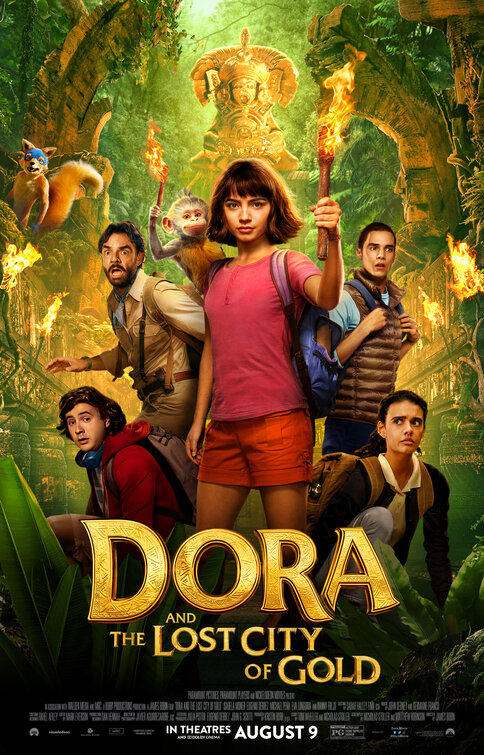Boosted by an excellent performance by Isabella Moner as the title character, “Dora and the Lost City of Gold” is an entertaining mix of “Spy Kids” and Indiana Jones adventure and light comedy movies. The live-action film is based on Nickelodeon’s long-running animated series “Dora the Explorer” and incorporates an intriguing fusion of Latin American and contemporary American culture. The movie keeps the campy optimism of the series, the precocious positive outlook of the lead character, and focused on its target audience of younger children.
The film opens with a six-year old Dora growing up and learning how to play in the Amazon jungles with her “explorer” parents, Cole (Michael Pena) and Elana (Eva Longoria). Her parents have been searching for the lost Inca city of Parapata in Peru, which according to legend has a massive cache of gold and riches. Ten years later, Cole and Elana believe they have found the city’s site. They dispatch Dora to Los Angeles to live with her aunt and attend high school with her cousin, ostensibly to meet and socialize with kids her own age.
Now sixteen, Dora is a cultural outsider who also has to contend with the awkwardness of high school and not knowing anything about city life. Dora, ever the optimistic, tries to make due even as her cousin (and erstwhile best friend) Diego (Jeff Wahlburg) shuns her to be with the cool kids. When her parents go missing, Dora, Diego, and two of their high-school acquaintances (including her nemesis) are kidnapped by treasurer hunters. Dora must find her parents, keep her friends alive, and outwit the treasurer hunters to survive.
The screenwriters and Nickelodeon have done an admirable job of linking the story in the movie to the animated series without losing its spirit. A seven-year old Dora can get away with her fanciful explorations in the fantastical world of animation. In live action, audiences, including kids, would struggle with the story and characters’ plausibility. Advancing her age to an innocent and naive sixteen year old allows the film to tap into the capabilities of experienced actors and provide more depth to the storylines and subplots. Younger children can still connect and relate to a teenage Dora. CGI and animation technology also allows the story to retain some of its animated elements, including an important role for her companion, Boots the monkey.
Since this is a children’s movie, the plot is predictable. But the story has enough twists older audiences will stay engaged. The combination of animation with live action provides a magical realism that most audiences will enjoy as well, providing a visual and storytelling link between the cartoon and the movie. At times, however, the movie seems like it’s teeing itself up as a theme park ride in Adventureland. More creatively, the story fuses Latain American and American culture seamlessly in a way that may foreshadow future filmmaking in a multicultural context.
The movie is buoyed by excellent performances — even if a little over the top for comedic relief — by Longoria (Elana), Pena (Cole), Eugenio Derbez (another explorer who befriends Dora), Wahlberg (Diego), Nicholas Coombe (as a nerdy high school friend who befriends Dora), and Madeleine Madden (as Dora’s high school nemesis).
Overall, “Dora and the Lost City of Gold” is decidedly family-friendly excursion that never strays from understanding and connecting with its core audience. Watching this movie is an enjoyable way to spend the afternoon if you have younger children and you recognize the limits of the genre.
